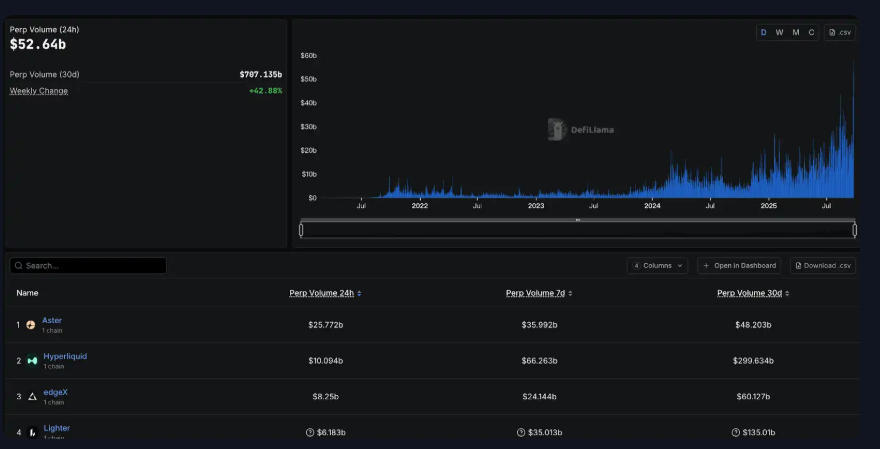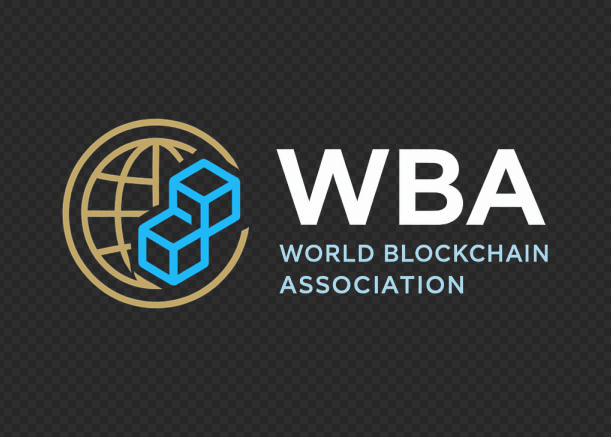
September 27, 2025 | By World Blockchain Association
The decentralized perpetual exchange (PerpDEX) sector is entering a decisive phase of transformation. According to the World Blockchain Association (WBA), Hyperliquid—a pioneer of order-book-based decentralized derivatives—now finds itself at a crossroads, challenged by emerging players such as Aster DEX while also innovating aggressively within its ecosystem. This analysis explores the structural shifts in the global Cryptocurrency, Bitcoin, Ethereum, DeFi, Web3, NFT, DAO, Tokenization, and Stablecoin landscape, with Hyperliquid’s evolving strategy at the center of attention.
Global Growth of Perpetual DEXs
The PerpDEX industry has expanded at an unprecedented pace. By September 2025, daily trading volume across decentralized perpetual exchanges surpassed $52 billion, representing a 530% increase since the start of the year. Monthly cumulative volumes have exceeded $13 trillion, highlighting a significant transfer of market activity away from centralized platforms.
The World Blockchain Association points out that this shift is driven by three core factors:
- Breakthroughs in on-chain performance and order matching technologies.
- Rising user demand for trustless, self-custodied derivatives.
- Intensifying regulatory scrutiny on centralized exchanges.
As a result, PerpDEXs now account for nearly 26% of the crypto derivatives market, up from single-digit percentages just one year ago.
Within this competitive landscape, two major models dominate:
- Order-book protocols such as Hyperliquid and dYdX, offering precise price discovery and deep liquidity tailored for professional traders.
- AMM-driven protocols like GMX and Gains Network, which attract retail users through ease of use and instant liquidity.
Hybrid models are emerging as well—Jupiter Perps, for example, combines order books with automated liquidity pools.
Aster DEX’s Meteoric Rise
The most disruptive new entrant in 2025 has been Aster DEX, born from the merger of APX Finance and Astherus. Backed by YZi Labs and prominent supporters including CZ, Aster achieved explosive growth immediately after launch:
- Token surged 1650% on release day (Sept 17).
- First-day trading volume reached $371 million.
- Over 330,000 new wallet addresses joined within 24 hours.
From a technical perspective, World Blockchain Association notes that Aster has attracted users by radically enhancing the DeFi trading experience:
- Leverage of up to 1001x, appealing to speculative traders.
- “Hidden order” functionality inspired by dark pools, shielding whales from MEV attacks.
- Yield-integrated collateral, allowing users to trade with income-generating assets such as asBNB while simultaneously earning 5–7% baseline yields.
Within weeks, Aster’s TVL skyrocketed from $370M to $1.73B (+328%), with daily trading volumes surpassing $20B—in some cases overtaking Hyperliquid.
Yet, community sentiment diverges. Professional traders remain loyal to Hyperliquid for its stability and execution certainty, while retail users and multi-chain participants prefer Aster’s user-friendly, CEX-like interface.
Hyperliquid’s Strengths and Pressures
Hyperliquid remains the most technologically advanced PerpDEX, with its HyperCore architecture achieving:
- 200,000 orders per second throughput.
- 0.2-second execution latency.
- Over $2.76 trillion in cumulative trading volume to date.
However, market share erosion is evident. Hyperliquid’s dominance fell from 80% in August to 38% by late September 2025, largely due to Aster’s cross-chain aggregation model.
Despite this, Hyperliquid continues to hold critical advantages:
- Tightest spreads on Bitcoin and Ethereum (0.1–0.2bps).
- Single-block finality, reducing settlement risk.
- Deepest liquidity pools, with $133.5B open interest.
- Deflationary tokenomics, channeling 99% of protocol revenue into HYPE token buybacks ($20.1B annualized).
WBA emphasizes that Hyperliquid’s core user base is more sustainable. Metrics show that 82.5K daily active addresses translate into 3.65M monthly actives, with an OI-to-volume ratio of 287%. In contrast, Aster’s user activity skews heavily toward short-term speculation (ratio: 12%).
Ecosystem Expansion: Hyperliquid’s Strategic Moat
Hyperliquid is no longer just a trading venue. It has evolved into a comprehensive DeFi ecosystem, with over 100 integrated projects building atop its infrastructure. According to World Blockchain Association analysis, this network effect is its true moat.
Key pillars include:
- Kinetiq – Liquidity Staking Hub
- TVL: $1.75B (78% of ecosystem share).
- StakeHub algorithm optimizes validator delegation with ML-based scoring.
- Integrated with Pendle for yield tokenization.
- $KNTQ governance token to launch via airdrop.
- Based – Mobile SuperApp
- Processes 7% of Hyperliquid’s total trading volume.
- Dual-token system: $PUP (XP booster) + $BASED (governance).
- Visa-linked debit card bridges crypto to fiat.
- Pendle – Yield Tokenization Giant
- Unlocks structured yield strategies by splitting assets into PT/ YT.
- TVL on HyperEVM: $12.3B.
- Seamlessly integrated with Kinetiq’s kHYPE liquidity.
- HyperLend – Lending Infrastructure
- TVL: $524M, built on optimized Aave v3 architecture.
- HyperLoop: one-click leveraged looping via flash loans.
- Generates $15.9M annualized revenue.
- Hyperbeat – All-in-One DeFi Dashboard
- $387M TVL; backed by Electric Capital & Coinbase Ventures.
- Auto-yield strategies for mainstream adoption.
- USDH – Native Stablecoin (Q4 Launch)
- Backed by U.S. Treasuries via Stripe Bridge and BlackRock partnerships.
- Compatible with both HyperEVM (ERC-20) and HyperCore (HIP-1).
- Expected to manage $5.5B in reserves, with 95% of yield channeled into HYPE buybacks.
Looking Ahead: HIP-3 and the Future of On-Chain Derivatives
Hyperliquid’s HIP-3 proposal is set to transform its growth trajectory by enabling permissionless markets. This could unlock exotic perpetual contracts such as:
- RWA-linked futures (commodities, real estate).
- AI compute power derivatives.
- Cross-chain risk hedging instruments.
The introduction of USDH further positions Hyperliquid to compete directly against USDC and other global stablecoins, reinforcing self-sufficiency in liquidity.
However, challenges remain. A looming 71% token unlock (Nov 29, 2025) could pressure HYPE’s price unless ecosystem revenues grow proportionally. Success will hinge on whether Hyperliquid can leverage its network effect, institutional-grade infrastructure, and deflationary economics to maintain dominance in the face of new entrants.
Conclusion
The World Blockchain Association reports that the global PerpDEX landscape is entering a phase of intense competition and consolidation. While Aster DEX has captured market share through aggressive leverage, multi-chain integration, and CEX-like UX, Hyperliquid’s advantage lies in its institutional-grade infrastructure, sustainable user base, and thriving DeFi ecosystem.
If HIP-3 and USDH deliver on expectations, Hyperliquid could redefine decentralized derivatives once again, shaping the future of Cryptocurrency, Bitcoin, Ethereum, DeFi, Stablecoin ecosystems, and the broader Web3 economy.
About the World Blockchain Association
The World Blockchain Association (WBA) is a global organization dedicated to advancing knowledge, policy dialogue, and innovation in blockchain and digital finance. As a leader in the blockchain and cryptocurrency space, the WBA provides stakeholders with trusted insights at the intersection of technology, regulation, and global economic trends through research, reporting, and thought leadership.
Website: WorldBlockchainAssociation.org
Email: TheWorldBlockchainAssociation@gmail.com






